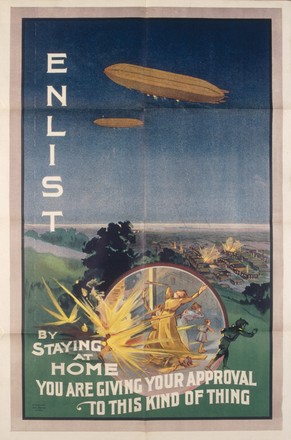
Enlistment poster
c1916
Printed ephemera
Published by WA Gullick, government printer, Sydney
Bequest of Sir William Dixson, 1952
F91/32
Printed ephemera
Published by WA Gullick, government printer, Sydney
Bequest of Sir William Dixson, 1952
F91/32
Despite the early rush to enlist, by 1916 the Australian military faced a critical shortage and the pressure on eligible men to enlist became enormous. Posters were an important element of government campaigns to persuade volunteers to sign up. With slogans such as, ‘Defend your homes, your women and your children’, ‘Don’t stand looking at this. Go and help’ and ‘Get into Khaki, your comrades at Gallipoli need you’, these posters directly targeted strong emotions and values: loyalty and national pride, patriotism, mateship and adventure, as well as guilt, fear and hatred of the enemy.
Along with newspaper editorials and much of the public debate, recruitment posters presented a highly simplified and polarised view of the issue: as put by the Sydney Morning Herald, ‘There are two classes of Australians in this war, those who go to it and those who stay behind.’*
The pressure around enlisting culminated in the Conscription referendums of October 1916 and December 1917 (both narrowly defeated), which are still considered the most bitter and divisive in Australia’s history.


 Back to list
Back to list